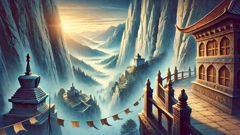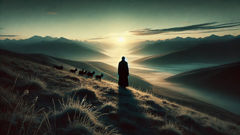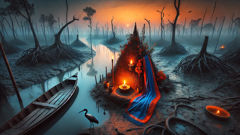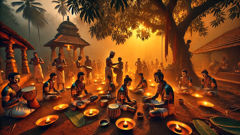Introduction
Beyond maps and merchants' gossip, beyond the weathered names on cartographers' charts, there is a place that belongs more to the breath of story than to any surveyor’s ledger: Shambhala. Mentioned in the soft, secretive lines of ancient Tibetan texts and spoken of in corridor whispers inside monastery walls, Shambhala is at once geography and metaphor — a kingdom hidden among the highest ridges of the Himalayas where peace is taught like a craft and wisdom hangs like prayer flags across its air. To the villagers of lower valleys it is a parable, told to children who press their palms to warm cups of tea and ask why travellers sometimes disappear into the snow. To a monk bent over illuminated manuscripts it is an instructive allegory: a map to inner calm, disguised as topography. To the bold it is a promise: a physical place, guarded by mountains and silence, where time loosens its grip and eyes can see more than surface light. The legend folds into the region like fog — sometimes lifting to reveal carved stone gateways, the hint of terraced gardens cut into cliffs, and monasteries whose bells keep a different clock. Sometimes it retreats, leaving pilgrims to trace footprints that vanish overnight. This retelling is both guide and reverence: it will describe the wind-sculpted passes and the names of sages who walked them, the rituals that warded off fear, the customs that turned solitude into a shared discipline. It will also follow seekers — merchants, soldiers, scholars, and ordinary folk — whose lives were altered by an encounter with the idea of a kingdom that could be both refuge and demand. In the telling, Shambhala becomes an axis around which the mountains rotate; the reader will move from fiords of white to inner chambers of silence, from the brittle sound of bone wind to the soft echo of a man learning to let go. Whether you approach it as history, myth, or mirror, the legend blooms in the high air, insisting that some destinations are less about arrival and more about the person who learns to travel differently.
The Map of Whispering Snow
The first accounts that hint at Shambhala arrive in phrases so careful they feel like the touch of gloves. Monastic scribes copied lines that spoke of a valley unreachable by ordinary travelers: "When the snow no longer stings the skin, when the wind ceases to ask for names, you will find a gate." Those sentences were wrapped in commentaries, annotations, the meticulous notations of scholars who believed clarity would betray secrecy. But secrecy, like river stones, wears thin under patient hands. By reading across the fragments — a merchant's ledger describing a trader who never returned, a soldier's marginal note about a white stupa that appeared overnight, a hermit's sketch of a three-tiered pavilion balanced on a cliff — a picture forms that is at once improbable and plausible. Shambhala arises, in these layered testimonies, as a place defined by thresholds. There are entry rituals: stones turned in a particular sequence, offerings of barley and tea left in enclosed hollows, the recitation of specific mantras at crossroads where three ridges meet. The rituals sound like housekeeping, almost disappointingly domestic, until one recognizes their purpose: they order attention. The travelers who survived to tell of Shambhala were those who could stand still enough to hear the mountain's cadence; the ones who rushed were redirected or snowbound, their stories becoming the kind of warning that also reads like prophecy.
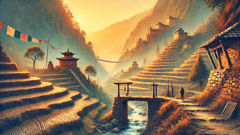
Access to Shambhala is not a single road but a set of conditions. Geography matters — steep gullies, avalanched terraces, a sun that slides like a coin behind a mountain — but so do disposition and intention. A merchant named Tenzin, who appears in two different chronicles with slight variations (sometimes called Tenzin the Quiet, sometimes Tenzin the Restless), was said to have stumbled into an orchard of glasslike pears that hummed when the wind passed. He did not pluck a fruit. He did not even step off the path. Those small refusals are the threads the stories offer: they reward restraint and punish the appetite for easy gain. The claim that Shambhala exists at the intersection of outer and inner terrain is not unique to Tibetan lore; many cultures speak of hidden cities that reveal themselves to the worthy. Yet the Himalayan framing gives it a particular character. Here, altitude itself becomes a teacher. The thin air reduces the demand of the senses; hunger, cold, and vertigo narrow a traveler’s world until only a single, sharpened question remains: What matters? Pilgrims describe an encounter with spatial silence, a hush that is not the absence of sound but the elimination of noise. In that stillness, details rearrange themselves. A weathered pilgrim will speak of a stupa whose stones were warmed not by the sun but by some interior light, of a courtyard ringed with trees that had leaves like small mirrors, of a monk whose eyes reflected stars that should not be visible in daylight. These descriptions border on the allegorical, and indeed they are often read that way by the very people who claim to have seen them.
Yet it is wrong to treat the cartographic and the mythic as entirely separate. The plates of regional geography often align with the old manuscripts; ridges listed in travelogues correspond to valleys named in liturgies. A map discovered in a provincial monastery—roughly sketched, ink smudged by decades of folded hands—features a narrow loop road that fades into clouds right where older texts say a gate swings open for those "who have practiced stillness for ten winters." Whether this was a code for meditation practice or a literal note about a weather-limited pass is open to interpretation. What is not open to debate is the way these details anchor belief: they give seekers something to follow whose texture is neither wholly spiritual nor wholly earthly. The boundary collapses. A trader can, after a long winter, learn the names of meditative postures as carefully as he knows the weight of exported salt. A lama may learn which knife-edge ridge provides the best view of a valley's irrigation system and, with that view, the practicalities of life there. This blending explains how Shambhala may have remained alive in both the oral memory of shepherds and the illuminated pages of monasteries: it appeals to heart and hand at once.
The people said to inhabit the hidden valley—call them custodians, residents, or the kingdom's quiet heart—are described with the same mixture of ordinary detail and luminous insinuation. They farm terraces that run like stitched ribbons across the hills, growing barley and a green plant that some accounts label as "medicine-grain," the properties of which vary from healer to healer. They construct stupas with a single eye-shaped stone at their center, and they keep libraries of scrolls written in a script that borrows from known alphabets but refuses to be translated cleanly into the ledgered languages of neighboring valleys. These are not picturesque folk preserved in amber; they are pragmatic, hospitable, and suspicious of ostentation. Hospitality in Shambhala is thorough: guests are fed with steaming bowls of barley soup, are given a place to sleep facing the eastern snow, and are asked to work for a day in exchange for stories. The stories given in return are not always flattering. They include admonitions to value time, to refuse petty cruelty, and to hold silence as a form of speech. A recurring motif in those stories is the mirror: not a polished instrument but an ordinary shard of metal that, when gazed into honestly, returns an image of the self unadorned by excuses. The mirror is often a test and a gift; those who meet their reflected gaze without flinching are permitted to remain a little longer.
Trade routes that once skirted the outer edges of Shambhala's rumored domain adapted to the legend. Shamans and sages became part of caravans. A healer's offering of a particular seed or an incantation could be traded for the news that a new gate had appeared, or that winter had refused to close over a particular gorge. Outsiders and insiders exchanged not just goods but habits: the amplitude of prayer recitation, the care with which tents are pegged into permafrost, the art of brewing tea without letting the water boil away its air. It is tempting to romanticize these exchanges, to imagine a kingdom that refused everything modern. In reality, the accounts we have speak of a people in conversation with the world, not in seclusion from it. They accepted travelers who were willing to learn and to be remade by the valley's peculiar economy of attention.
If one searches for the origin of the legend, one finds a confluence: the consolidation of Tibetan spiritual doctrine, the needs of travelers crossing weather-ravaged passes, and the human hunger for a model of society that privileges wisdom over wealth. Shambhala, as described across documents, custom, and rumor, becomes a place where spiritual practice is not a private pursuit but social infrastructure. Meditation schedules are agricultural timetables; ethics are as practical as irrigation. In such a place, governance resembles stewardship more than rule: elders are chosen for their capacity to listen, not for their prowess in arms; disputes are settled by communal tasks that restore both relationship and land. This practical mysticism creates a plausible answer to why so many accounts emphasize humility and competence rather than revelatory miracles. The miraculous exists, but it is woven into the ordinary: a bell that rings without a visible striker, a drought eased by a careful realignment of terraces, a child's laughter that seems to rearrange the weather.
Thus the map of whispering snow that points toward Shambhala is not drawn only by compasses and stars but by the steady hand of practice. The valley is a palimpsest of decisions made to sustain life under extreme conditions and of rituals adapted to keep attention from drifting into despair. Whether Shambhala is a real place, a metaphor, or an emergent practice that communities can cultivate within themselves, the stories invite a question that continues to move readers: What would it mean to build a society where wisdom is the primary currency? That question, perhaps, is the true map the legend offers.
Pilgrims and the Gates of Silence
Pilgrimage to the rumored entrances of Shambhala reads like a catalog of vows. Men and women set out for reasons as varied as their faces: a widow who wanted to lay down the knot of grief she carried, a scholar who believed that a single scroll in the valley's library could complete a lifetime of study, a young soldier who wished to exchange weapons for ploughshares. The stories converge in the mythic fact of waiting. Waiting is not passive; it is an apprenticeship in tempering desire. At the appointed junctions — a boulder split by lightning, a pine that grows at an impossible angle, a narrow arch called the Needle — travelers find themselves tested. The tests are small and precise. One requires the person to walk a distance without speaking; another demands the mending of a pilgrim’s cloak with thread pulled from the hem of one's guilt. These tasks are absurd until recognized as training in restraint. The earliest chronicles of pilgrimage emphasize that few pass through the gates on their first attempt. The mountain returns many seekers, but it returns them quieter, smaller by some measures and larger by others.
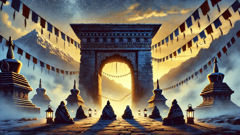
Histories of the routes offer a tapestry of encounters. The caravan tracks that approach the hidden valley are littered with temporary settlements that serve as waystations. Here, monks teach improvised meditation to merchants whose livelihoods depend on speed and calculation. Artisans exchange simple repairs for lessons in breath control. An old woman named Pema, who tended a teahouse near a known threshold, appears in multiple accounts as a kind of midwife to travelers’ transformations. She served tea boiled with a root that numbed the wind's bite and listened without insisting on the kind of narrative that would force a person's change into recognizably moral arcs. Many who passed through Pema's teahouse left with a small cloth tied with six knots — a token that signaled their intention to continue the route with integrity. The knotting ritual became part of the pilgrimage's social language: one knot for the vow to be honest, another for the vow to return if rescued, and so on. Tokens like these illustrate how the outward journey and inner discipline were woven into the fabric of daily practice.
A repeated motif in pilgrims’ testimonies is the Gate of Silence, a ritualized threshold that demands an offering not of coin but of something more abstract: a silence taken for a season. The Gate was more often a place of practice than stone — a plateau where the wind is clean enough to carry the edges of speech away. To enter, one must remain silent long enough that the urge to speak becomes visible as a physical sensation: the throat tightens, the hands gesture, old stories rise like steam. The Gate of Silence teaches a person to listen. Many accounts recount how a traveler, after hours of silent waiting, recognized the rustle of a mountain hare’s fur as a distinct voice, or learned to hear the difference between snow falling on stone and snow falling on a roof. This heightened listening reorganized priorities. A man who could finally distinguish these subtleties would find, in one telling story, that the gate opened, not because a barrier dissolved, but because a new world of perception made him no longer stumble against the old boundaries.
Encounters with the valley's residents are often described with a tone of domestic surprise. The inhabitants of Shambhala are not ascetic ghosts; they are gardeners and carpenters who practice a kind of careful abundance. They keep children in schools that teach arithmetic alongside compassion and elder councils that resolve disputes by rearranging chores so that no one person bears the burden of another's grief. These practices produce a political economy in which governance is intimate and restorative. When outsiders arrive, they are sometimes mistaken for emissaries from other states and sometimes mistaken for teachers sent by the valley itself. A common narrative follows: a frazzled envoy arrives expecting to barter for spices or mineral wealth and instead learns a more bewildering lesson about reciprocity. He is asked to repair a leaning wall, to listen as a child plays a riddle, to sit under a bell that rings at unpredictable intervals until he learns to align his breath with it. The envoy returns not with a treasure chest but with a ledger filled with small notes about how to maintain a road without destroying a wetland, or how to settle a conflict by planting a tree whose fruit will bind two households together. The envoy's superiors are baffled; the envoy is changed.
Religious life in Shambhala, as told by pilgrims, is unshowy. Rituals that outsiders expect to be theatrical are instead of a practical drama: morning ceremonies that double as water management plans, communal chanting that acts as a clock for work shifts, silent shared meals that train appetite to be cooperative, not competitive. Yet there are mysteries that resist utilitarian explanation: a bell said to sound the longitude of a person's grief, a library whose scrolls can reorganize if the reader's mind is ready for the next arrangement of words, a starry garden where constellations are mapped into the patterning of crop cycles. For many narrators, those mysteries are evidence of the valley's otherness; for some they are the valley’s pedagogy — methods meant to teach people how to live in a world that is at once fragile and generous.
Among the most persistent motifs in these narratives is the King of Shambhala, a title that confuses historians and poets alike. The king is described alternately as warrior-ascetic, wise guardian, and literal sovereign whose reign is measured in the keeping of a delicate balance: he (or she, in some later variants) must calibrate the valley's defenses without tipping into paranoia, welcome strangers without enabling exploitation, and preserve knowledge while allowing it to be questioned. This paradigm suggests a model of leadership in which authority is distributed by capacity rather than inherited by accident. Many tales present the king not as a figure above the people but as their most dedicated servant: attending to irrigation canals at dawn, answering disputes at dusk, and listening to the valley's children as if their misperceptions were central to governance. The King’s rule is therefore pedagogical: rulership is a practice of care and listening rather than an assertion of dominance.
Pilgrims who stayed long enough to earn the valley’s trust often returned to their homelands carrying small, practical gifts: a seed that resisted blight, a song for calming anxious animals, or a way to shape a roof to channel snow into reservoirs. More often, they returned with subtler gifts: habits that allowed their communities to weather hardship without collapsing into blame. These returns created the story’s outward wind: the legend moved beyond the valley's borders because the people who left carried something worth imitating. Shambhala thus functions as an idea with centrifugal force: it shapes lives beyond its supposed borders because its practices are replicable, useful, and, above all, humane.
Not every traveler prospers. Some accounts are cautionary. A soldier who came seeking a place to hide amassed a band of followers who tried to seize resources, and the valley's people responded by teaching them to plough for a season. The humiliation of honest labor dissolved the soldiers’ desire for conquest more effectively than any battle. A merchant who tried to steal a sacred text was found out and given a task that required months of tending to another's aging goats. The transformation was slow, and in some versions, incomplete. Those versions remind readers that Shambhala does not offer easy redemption; it offers conditions under which transformation can occur, but only if the person is willing to meet the valley halfway.
Across centuries, the Gates of Silence have remained a motif for both disappearance and emergence. People go to Shambhala expecting miracles; they find instead a regimen of attention. The valley, whether literal or allegorical, refuses shortcuts. Its lessons insist on patience, practical care, and the slow accumulation of listening. For those who accept that curriculum, the legend promises something radical: a place where governance is gentle, where knowledge is integrated with stewardship, and where the social unit values repair over domination. The Gates of Silence open for those who are prepared to stop speaking the hard, brittle words of fear. In their stead one learns to craft sentences from patience and to act with the quiet mathematics of communal life. It is here, at the intersection of aspiration and practice, that the legend of Shambhala does its most subversive work: it suggests that a kingdom of wisdom is built not by edicts but by the steady, often invisible labor of ordinary people living according to uncommon attention.
Conclusion
Stories of Shambhala persist because they answer a question that survives political upheaval and the erosion of borders: what does it look like when a community arranges itself to favor wisdom over spectacle and care over conquest? The legend does not insist on literal geography as its only truth. It also offers a blueprint of practices — rituals of attention, governance by listening, labor that mends both land and relationship — that can be enacted anywhere. The idea of a hidden kingdom, guarded by snow and silence, helps people imagine a society organized around repair, humility, and the remaking of desire. Pilgrims return with seeds and songs, but more importantly they return with habits of attention that slowly alter their homes. Monasteries preserve the texts, scholars debate their meaning, and villagers fold the legend into recipes for survival. Whether you encounter Shambhala as a valley visible from a high pass or as a practice cultivated in a kitchen or a council hall, the tale offers a promise: that peace is not a static trophy but a living craft, honed by the quiet insistence of ordinary work and the stubborn refusal to sprint past what truly matters. That promise is the kingdom’s real treasure, and it demands nothing less than a lifetime of listening.

